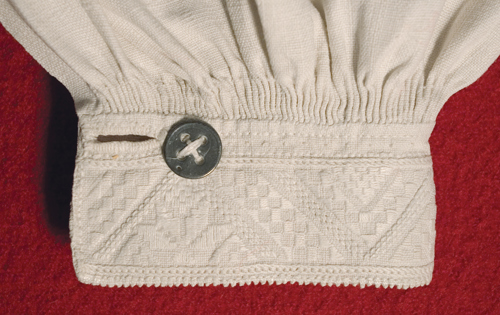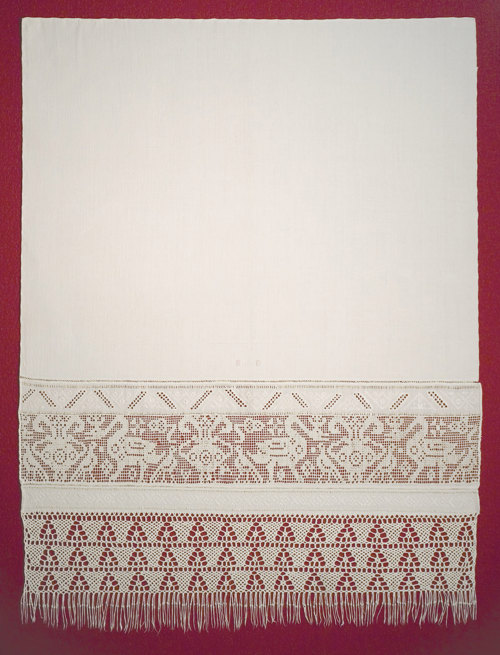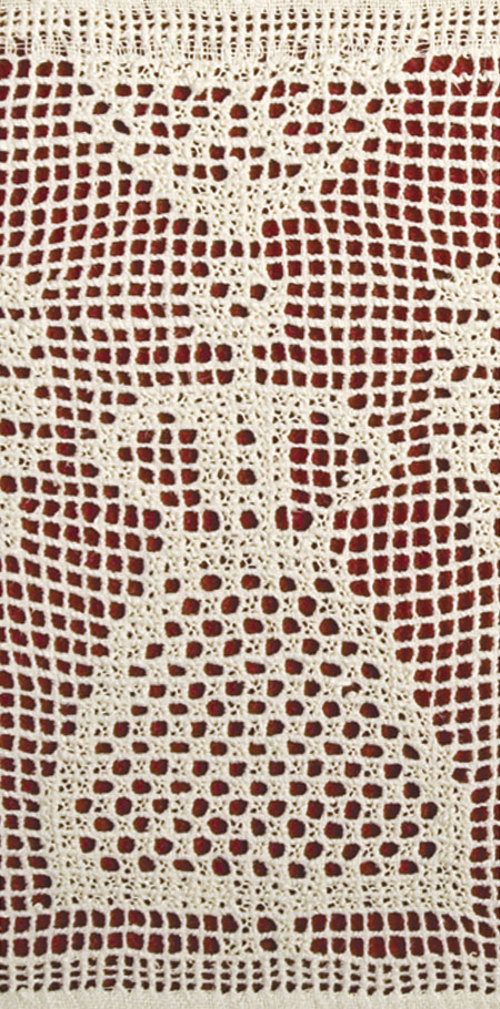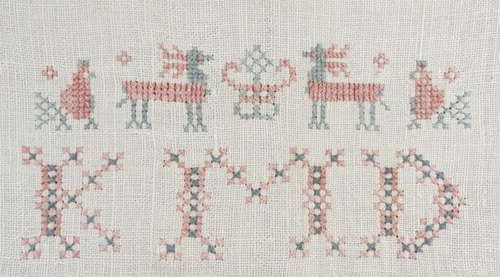Counted thread work
Here on this page, you will find examples of textiles that incorporate the counted-thread embroidery technique.

Shirt with counted thread work
Shirt with counted thread work on shoulders, cuffs and front. The short cuff pieces are made separately and sewn onto the shirt later. The pattern of stars with eight points and diagonal stripes with small squares is typical of counted thread work. The metal buttons did not originally belong to the cuffs. A counted thread work border has been sewn along the opening on the front of the shirt which copies thepatterns from the middle of the shoulder piece.The opening ends in a bar which resembles a Hedebo edge. The collar is finished with needle lace consisting of dense rows of Danish buttonhole stitch and scallops.
Please note
- How “the chain”, which frames the borders along the opening, merges into blanket stitch around the lace eyelets in the corners
- The fine wrinkles at the top of the sleeve, which are held in place by smocking and chain stitch
- The delicate pleats and two rows of back stitching, with knots between the rows, on the cuffs
- The embroidery on the small lobe at the bottom of each of the side slits




Decorative towel with counted thread work, square cut work
Decorative towel with counted thread work and square cut work. This is made of four equal pieces of fabric sewn together. A purchased fringe was added to the bottom piece. The top border has a pattern of three large squared areas filled with a well composed mixture of square cut work and counted thread work. The border in the middle contains the central motif: two big lions and two women around a tree of life. Above and below the two upper main borders is wide, woven hemstitching surrounded by a narrow woven hemstitch and a zigzag hemstitch respectively. The lowest border has a cross as its central motif and along its sides a stylish flower arrangement surrounded by birds.
Please note
- The square cut work border in the middle with all the small counted thread work patterns which the needlewoman used to fill out empty areas
- The small oblong holes in the lowest wide square cut work border
- The monogram sewn with eyelets and surrounded by red and blue cross stitching
- The stars in the counted thread work of the narrow borders





Decorative towel with square cut work, counted thread work, "hvidsøm"
The decorative towel is interesting because it contains nascent ”Hvidsøm”, in which the needlewoman has not yet started to use entwined shapes. The patterns are plain and geometrical. The upper border contains experimental ”Hvidsøm”. The other borders consist of geometrical patterns, flower arrangements, and birds in square cut work and counted thread work . In the border below the initials, stars are embroidered with counted thread work. The initials AHD are sewn in cross stitch and refer to Ane Hansdatter (the daughter of Hans) from Kildebrønde. She was born in 1820.
Please note
- The main borders are surrounded by different sets of darning hem stitch, with rows of square stitching on both sides
- The pattern in the upper border consisting of stars in square cut work placed in diagonal lines, forming large square areas. Inside the squares, flowers are embroidered with square cut work and ”Hvidsøm”. Outside the squares, there are flower arrangements in ”Hvidsøm”
- The bought fringes attached at the bottom






"Knædug" with drawn thread work, counted thread work, and square cut work
The ”knædug” consists of three pieces sewn together. The upper piece is a linen fabric with the initials B and D in cross-stitch. The centre piece contains embroidery in two borders. The upper one is narrow, with square cut work and counted thread work bordered by four-sided hemstitching above and below. The wide border, which forms the main motif, is embroidered with drawn thread work with interlocking. The motif is crowned swans, alternating with flower arrangements and small birds. The bottom piece of fabric consists of a narrow border with a geometrical pattern in counted thread work and a plaited warp.
Please note
- The motifs in square cut work in the top border are whipped at the edge with very unequal long stitches. Is this a part of the pattern, or bad embroidery technique?
- In the two joins of the fabric, herringbone stitching is used to make it look like zigzag hemstitching
- The pattern in the drawn thread work border is not centred
- The middle letter in the monogram has been unpicked




Knædug in drawn thread work, counted thread work, and square cut work
The wide border is drawn thread work with whip stitch. The motif is a simple alternation between women with headwear and flower arrangements. Above and below the drawn thread work border are two narrow borders of counted thread work and square cut work. Above the borders is a faded red cross monogram with the initials BID, the date 1839, and a flower arrangement. The drawn thread work border is sewn to the bottom of a piece of fabric. This has been seamed before an open plaited warp, on a narrow piece of fabric of the same quality, was attached.
Please note
- The backstitching around all the small areas of square cut work
- How close to the selvage the withdrawn threads of the drawn thread work are cut
- The stitches holding the pieces of fabric together are made by winding hemstitching, sewn over thicker thread, which spans across the two pieces
- A thin thread is drawn around the small ‘stains’ below the large flowers






”Knædug” with square cut work and counted thread work.
The ”knædug” has a plain pattern with square areas embroidered with counted thread work. Inside the areas, hearts, stars, and squares are embroidered with square cut work and counted thread work. The embroidery is divided into borders by H hemstitching. A loose plaited warp of a more coarse fabric is attached to the ”knædug” like a ‘false’ hemstitch, by weaving over thicker threads which span the two pieces of fabric.
Please note
- How the needlewoman uses her imagination with counted thread work and square cut work patterns in the small diagonal squares which form the characteristic diagonal rows of counted thread work
- How some of the square cut work areas are surrounded by a row of backstitch while others are not
- The monograms embroidered with both red and blue cross-stitching, with crowns flanked by reindeer and cockerels above them
- The embroidery is made by a very experienced needlewoman. The embroidery was given to Greve Museum together with another and, together with these, have been shown in the exhibition Folk Embroideries at the end of the 1950s




